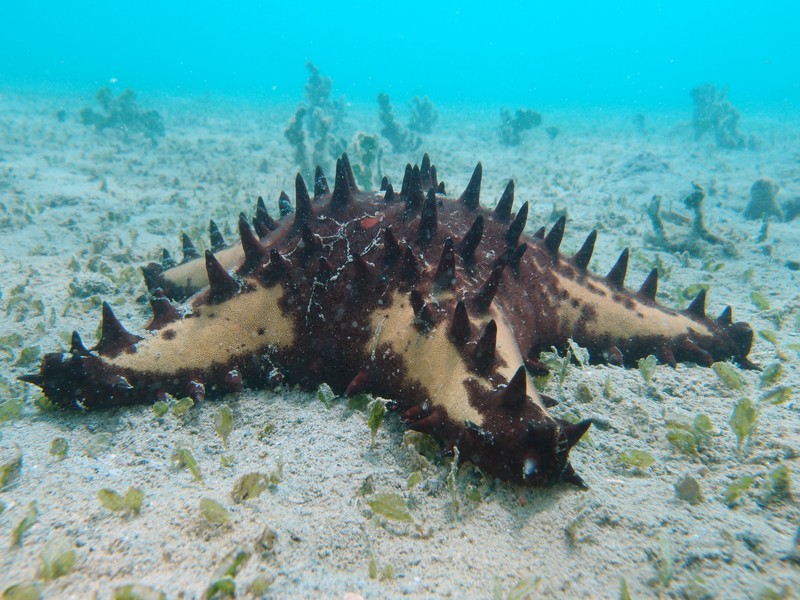PROTOREASTER NODOSUS - (LINNAEUS, 1758)
Echinodermata (Phylum) > Asterozoa (Subphylum) > Asteroidea (Class) > Valvatacea (Superorder) > Valvatida (Order) > Oreasteridae (Family) > Protoreaster (Genus)
étoile à bosses, étoile à cornes, knobby sea star, horned sea star
Description
Grande étoile de mer, jusqu'à 40cm de diamètre, facilement identifiable grâce à de grosses bosses présentes sur ses bras courts et sa partie centrale. Celle-ci est élevée, de forme pyramidale avec des tubercules assez pointus pour ressembler à des cornes. Sa surface est dure mais non rugueuse, de couleur crème, pêche ou orange. Les tubercules sont généralement entièrement noirs, mais peuvent avoir aussi des reflets bleus, violet, rouges ou verts. La face orale est blanche avec de fins sillons ambulacraires. Taille adulte 30 - 40 cm. Profondeur 1 - 30 m.
Généralités
Les étoiles de mer ont un système hydraulique qui leur permet de se déplacer et de se nourrir. Elles ouvrent, à l'aide de leurs bras, des mollusques bivalves comme des moules, puis sortent leur estomac pour digérer la partie comestible du mollusque. Les oursins sont également au menu et certaines espèces se nourrissent de coraux.
Particularités
Protoreaster nodosus est très commune à faible profondeur sur les platiers sableux recouverts d'herbiers de phanérogames, mais on peut la trouver jusqu'à 30m de profondeur.
Synonymes
Asterias dorsatus (Linnaeus, 1753)
Asterias nodosa (Linnaeus, 1758)
Oreaster clouei (Perrier, 1869 )
Oreaster franklini (Gray, 1840)
Oreaster hiulcus (Müller & Troschel, 1842)
Oreaster hondurae (Domantay & Roxas, 1938)
Oreaster intermedia (von Martens, 1866)
Oreaster mammosus (Perrier, 1869)
Oreaster modestus (Goto, 1914)
Oreaster mutica (von Martens, 1866)
Oreaster nahensis (Goto, 1914)
Oreaster nodosus (Bell, 1884)
Oreaster turritus (Gray, 1840)
Pentaceros clouei (Perrier, 1869)
Pentaceros franklini (Gray, 1840)
Pentaceros hiulcus Gray, 1840)
Pentaceros hiulcus (Muller & Troschel, 1842)
Pentaceros modestus (Gray, 1866)
Pentaceros nodosus (Linnaeus, 1758)
Pentaceros turritus (Gray, 1840)
----------------------------------------
Protoreaster nodosus is a species of sea star found in the warm, shallow waters of the Indo-Pacific region. Also known as "horned" or "Chocolate Chip" sea stars, they possess rows of spines or "horns"; black conical points arranged in a single row, radially on the dorsal side, which may erode and become blunt. These dark protrusions are used to scare away possible predators, by looking frightening or dangerous. On the ventral side, tube feet, purple in color (or pale, transparent pink), are arranged in rows on each arm. Most horned sea stars found are a roughly rigid five-pointed star-shape with tapering arms to the end, although there are anomalies like four or six-armed specimens; they may grow up to 30 centimetres in diameter. The sea stars are usually colored in shades of red or brown, but can be light tan, the color of cookie dough. This appearance, combined with the small horns on its dorsal side, give the sea star a look similar to that of a bumpy cookie. Horned sea stars prefer sheltered, sandy or slightly muddy bottoms more than hard substrata such as coral reef, and are frequently sighted conspicuously between the leaves of seagrasses on sea grass meadows or on blank stretch of coral sand. In shallow water, this species can be seen intertidally, occasionally exposed to the low tide. they do not withstand rapid changes well, however, and usually keep themselves underwater. In aquariums, these sea stars like to climb around on glass and also filters, which they can disrupt. Sometimes, many individuals of this species can be seen gathering on soft bottom with reason not very well known, probably to increase the chance of fertilization when spawning or simply a suitable feeding ground.
Prague sea aquarium
Horned sea stars seem to be opportunistic carnivores; adults are known to predate on most sessile life forms including hard corals and sponges in aquarium. In this same setting, they will hunt down snails and eat them. An individual of horned sea star also has been observed eating a sea urchin in their natural habitat. In public aquariums, these stars are sometimes target-fed with chopped squids, clams or shrimps, and are popular animals for touch pools as it is moderately large in number in some undisturbed areas. Horned sea stars need perfect water condition, suitable diet and proper acclimatization to thrive - thus, these sea stars did not fare very well, caused by several factors mentioned before in many home aquariums. In reef aquariums, they are regarded as undesirable as they have destructive tendencies of toppling decors and digesting patches of corals and sessile organisms; they are reasonably safe if kept in a fish-only aquarium. However, the sea stars are desirable for their cute appearance and relatively non-aggressive behavior.
In many tropical Asian and Pacific countries, horned sea stars are collected for sea shell trade for their ornate skeletons. In some areas overharvesting is an issue and reduces greatly the population of the echinoderms. Related to this species, the Atlantic Oreaster reticulatus, commonly known as Bahama Sea Star, is also a previously abundant species reduced in number due to the continuous harvesting by the industry and tourists alike.
As with other tropical echinoderms, commensal animals like shrimps (of genus Periclimenes), tiny brittle stars and even juvenile filefish can be found on the surfaces of a horned sea star. This may be attributed to its protective nature, as there are few predators that would dare to eat this echinoderm.
